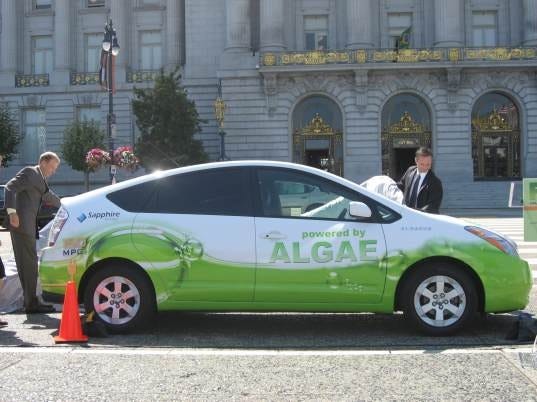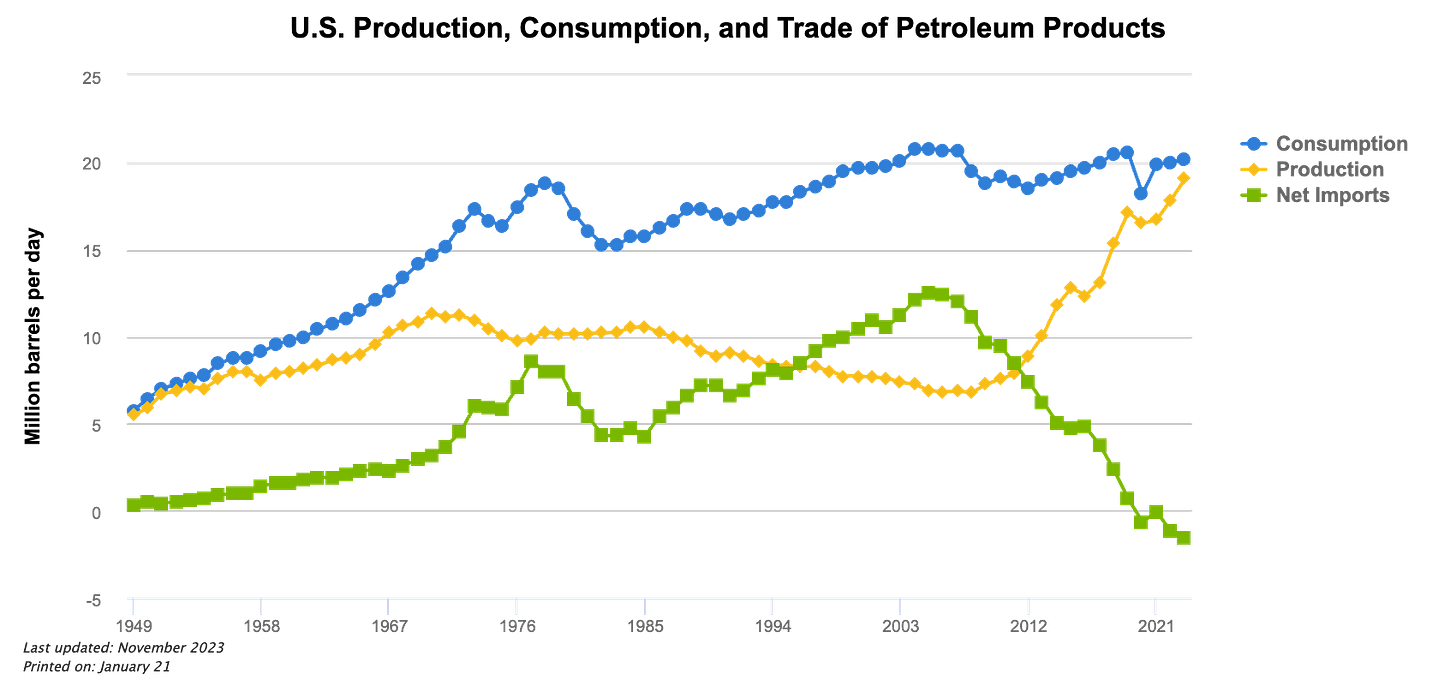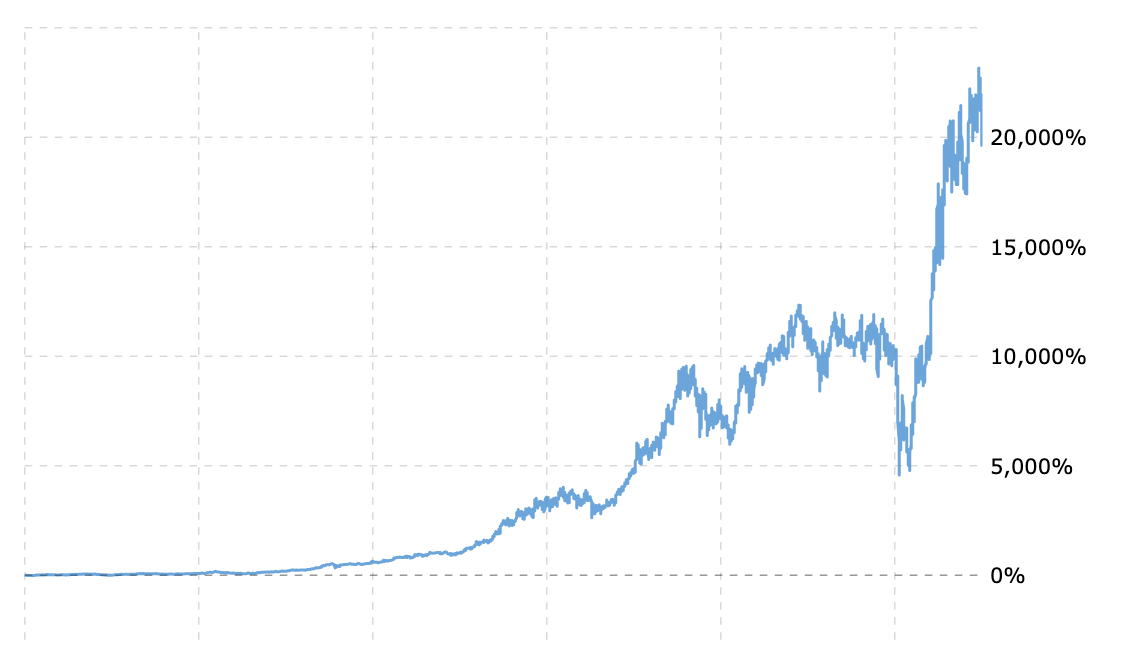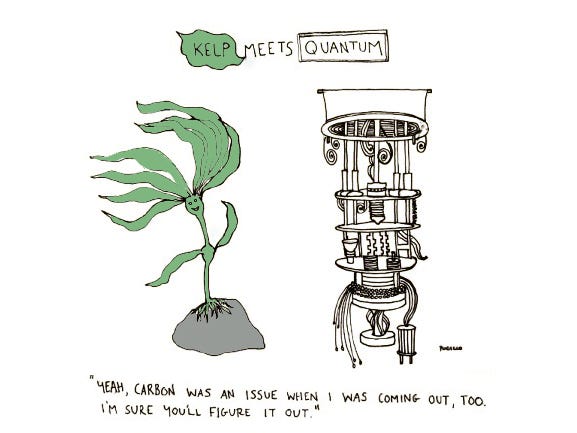We Forgot the "Algaeus," and that's OK
Episode #01. Algal fuels still running? Eli Cash and my first Wikipedia entry
Wading In 🏊🏼
This post is about the dream of algal biofuels, from future hope to forgotten hype (and back again?).
I plan to experiment a bit with the content structure and format of The Blob posts, but this one is more of a Deep Dive 🤿.
One constant is that every post will be accompanied by at least one hand-drawn algae-related cartoon (scroll to the bottom ☟)
🦠 Hope you enjoy 🦠 And feel free to reach out 👋🏼.
Keep Energy Weird
In November 2024, The U.S. Department of Energy’s Bioenergy Technologies Office (BETO) and Office of Fossil Energy and Carbon Management (FECM) announced $20.2 million in funding for 10 projects as a part of their MACRO1 program (Mixed Algae Conversion Research Opportunity to Advance Development of Mixed Algae for Biofuels and Bioproducts).”
Of the ten funded projects, only three were directly related to potential applications as biofuels, and all three focused on SAF (sustainable aviation fuels). The other projects were mainly for food, feed, and bio-plastics. Biofuels, once the flagship and namesake of many R&D efforts, have been quietly getting defunded.
That itself is not surprising, as there has been a steady heralding of their demise as a petroleum alternative for years. What’s surprising (and vital!) is that the dream lives on despite the odds against commercial success.
Because we are still searching for the El Dorado strain of algae that will perhaps finally break the commercialization barriers for fuel, we are reaping the benefits of the applied research in other fields — biotechnology, genetic engineering, wastewater treatment, CDR. This pioneering research is, in turn, priming the production of various high-value algal-based products, such as industrial materials/bioplastics, food, feed, fashion, beauty, and nutraceuticals (more to come on these👆🏼!).
Market analysts and pundits seem to regard biofuel R&D the same way Enlightenment scientists regarded alchemy: an intellectual errand for misguided visionaries (or fools). But they forget that without alchemy, there would be no oil paintings to celebrate the Enlightenment.
In other words, searching for gold (literally and metaphorically) opens unexpected doors.
Prelude: The Promise of Algae Biofuel
Like many Great American Energy stories, we can ultimately thank Jimmy Carter.
The silver lining of the 1970s energy crisis was an earnest initiative to investigate petroleum-based fuel alternatives. There was a clear need for an energy security strategy that reduced dependence on foreign oil, with any implications for climate change as an ancillary benefit (if publicly acknowledged).2
One of the symbols of this brief but productive era was the solar panels installed on the roof of the White House, which Raegan promptly removed. Less public and more interesting was what Raegen (and George H.W. Bush) decided to keep.
Established by the Carter administration in 1978, the mission of the Department of Energy’s Aquatic Species Program (ASP) was to develop renewable transportation fuels from algae. After twenty years and $25M of R&D, the project was finally shelved by the Clinton Administration in 1998. Culminating in a 296-page retrospective/lessons learned report from National Renewal Energy Lab. This research formed much of our current understanding of algae metabolism and the systems engineering of microalgae algae production.
Here are the (vastly simplified) key takeaways:
Algal biofuels are technically possible to produce at scale
But they’re too expensive and energy-intensive to make economically feasible
At least without a genetically engineered strain that can far exceed biological productivity.
Even if researchers overcome these challenges, algal biofuel’’ contribution to the U.S. energy mix would likely be modest.
So… not a slam dunk for risk capital! But that’s 20 years of research, blazing a trail for future and adjacent applications of algal products, and developing a toolkit for genetic manipulation. To continue the metaphor, the ASP was an “alley” searching for an “oop.”
Algae redux
For about 10 years after the ASP folded, federal research funding for algae-based fuels seems to have cooled. Perhaps this has something to do with a shifted paradigm after September 11th, 2001, and the ensuing land wars in Asia —
But toward the tail end of George W. Bush’s second term, the Advanced Research Projects Agency-Energy (ARPA-E) was established under the banner of American competitiveness. Created in 2007 by the Bush II Administration, with $400M in funds allocated in the first year of the Obama administration, ARPA-E was intended to fund game-changing energy technologies that were too early for private-sector investment.
In part, the initiative was spurred by the Defense Advanced Research Projects Agency (DARPA)’s successes (think GPS, Siri, and the Internet).
Around the same time, the American auto industry faced an existential crisis. Just weeks after Barack Obama’s first election victory in December 2008, auto industry CEOs drove to DC in hybrid vehicles, hat in hand, with a clear message: “We messed up, but we’re going to get it right this time.”
Only two months earlier, the “Algaeus” graced American highways. Produced by aspirant biofuel producer Sapphire Energy, the vehicle conducted a 10-city, 3,750-mile pilot demonstration to raise awareness for alternative fuels. The trip culminated in the New York City premiere of the documentary film Fuel (film).
The vehicle was a marketing project intended to provide a model for the viability of algae-based biofuels as a market alternative to fossil fuels.
With funding, political capital, and social license, if there was ever a moment when the winds favored supporting algal-based biofuels, this was it. Further, the market forecasts looked rosy. Some estimated that alternative fuels derived from algae could reach billion-gallon production by 2014.
Fast forward a few years, and algae diesel seemed poised for prime time.
This was Barack Obama to an audience at the University of Miami in a 2012 speech about Energy policy. I’ve kept an extended excerpt as a nostalgic example of presidential remarks:
…
We’re making new investments in the development of gasoline and diesel and jet fuel that’s actually made from a plant-like substance -- algae. You’ve got a bunch of algae out here, right? (Laughter.) If we can figure out how to make energy out of that, we’ll be doing all right.
Believe it or not, we could replace up to 17 percent of the oil we import for transportation with this fuel that we can grow right here in the United States. And that means greater energy security. That means lower costs. It means more jobs. It means a stronger economy.
Now, none of the steps that I’ve talked about today is going to be a silver bullet. It’s not going to bring down gas prices tomorrow. Remember, if anybody says they got a plan for that -- what?
AUDIENCE: They're lying.
THE PRESIDENT: I’m just saying. (Applause.) We’re not going to, overnight, solve the problem of world oil markets. There is no silver bullet. There never has been.
But you never saw any Algaeus models on the road, and you probably never will. The Algaeus didn’t even have a Wikipedia page until this year (and it became my first and so far only contribution to Wikipedia!)
Although biofuels were hoped for and hyped, they faced what appeared to be insurmountable roadblocks to commercialization at scale. For this product to work, four gargantuan systems—both natural and social—would need to change.
Algae Biofuel’s 4 Horsemen
Biological 🏇🏻
Algae oil is produced by converting storage lipids in the algae cell (triacylglycerols, or TAGs). So, to grow and harvest algae at the commercial scale required to compete with petroleum, you need to have a lot of algae (biomass) and a high lipid quality and quantity.
The trick is that lipid production and growth rates don’t naturally work in tandem. Increasing lipid production will slow your growth rate and vice versa. The elusive holy grail (and there are some candidates) involves finding a resilient strain that can maximize lipid production (which is more energy-intensive than carbohydrate and protein production) and biomass while growing outdoors at a commercial scale.
Algae’s strength, photosynthesis, which converts sunlight into biomass, is also a natural bottleneck. The natural efficiency of most photosynthetic organisms is about 1-2% of the sunlight they receive. Algae do better, at around 4.5%, but any increase in efficiency would be a boon for biomass. Companies like Living Carbon are exploring the terrestrial potential.
Finally, changing algae’s DNA is difficult. Because algae have a low genetic throughput, their DNA cannot process much information at once, slowing fundamental research into strain improvements.
Cultural 🏇🏻
One of algae’s selling points is that it was a novel solution. Maybe even cool (I mean, the “Algaeus,” am I right?).
But 2008 was the same year the first Tesla Roadsters began regular production and rolling (conspicuously, I’m sure) into the driveways of 900 early adopters. This marketing campaign changed the conversation and ultimately redirected the winds of competition.
As an environmentalist and technology booster, why wait for biodiesel to arrive when you can skip the pump entirely? The biofuel dream, especially for automobiles, has become increasingly less relevant and exciting.
Biofuels sold us a future we couldn’t quite picture. Tesla sold the power of a retro-future, delivering an articulated dream.
Political 🏇🏻
Even under the best political conditions, structural short-termism threatens progress. Between 4-year presidential politics and the specter of midterms, the ballot box is impatient.
Back to Barack Obama’s speech at the University of Miami — Here’s how he followed the optimistic pitch quoted above:
…
Now, none of the steps that I’ve talked about today is going to be a silver bullet. It’s not going to bring down gas prices tomorrow. Remember, if anybody says they got a plan for that -- what?
AUDIENCE: They're lying.
THE PRESIDENT: I’m just saying. (Applause.) We’re not going to, overnight, solve the problem of world oil markets. There is no silver bullet. There never has been.
It’s a lesson we haven’t learned in American politics.
The political capital needed to educate and sell the American public on the biofuel strategy existed only briefly. Only months after a broad mandate Obama victory, with Detroit at the heel and allocated ARPA-E funding, the Tea Party was founded. A few months later, the Affordable Care Act began drawing heavily on the Administration’s available political resources. By 2010, after a mid-term shellacking and loss of a congressional majority, complete gridlock.
In American federal politics, the campaign never ends, and algae fuel is an easy target on the campaign trail.
Economic 🏇🏻
The final word.
As of 2008, petroleum production in the United States had been declining slowly and steadily while net imports were trending definitively upward.
By 2024, the United States had produced more crude oil than any other country. Yes, more than Russia and Saudi Arabia — it seems appropriate to note that 2008 was the year that the phrase(?) “Drill, Baby, Drill” was coined.
Since the beginning of the Obama administration, the oil and gas industry has truly thrived, primarily due to the technological advances associated with hydraulic fracturing (fracking) and the industry’s ability to extract gas from deep rock (and the government’s tacit approval).
This increase in natural gas production was an economic opportunity disguised as a “stepping stone” to clean energy production. Unfortunately, it's traditionally unprofitable for biofuels and the planet to bet against Exxon (for example 👇🏼).
Furthermore, biofuels have always been and continue to be uncompetitive. To achieve economic parity with petroleum, it’s estimated that algal biofuels would need to consistently triple biomass yields.
The EROI (Energy Return on Investment) is also absent. Algal bio-crude has an EROI value of around 1.5:1, meaning the energy gained from use only slightly exceeds the energy spent growing, harvesting, and converting it.
Petroleum, on the other hand, historically had EROI values around 20:1, meaning it provides 20 times the energy required to extract and refine it. Bridging this energy surplus gap is akin to a moonshot.
And ultimately, it’s just too expensive. Estimates range from 7.5 to 32.5 times the cost per barrel compared to petroleum ($300–$2,600 vs. $40–80 per barrel). The capital expenditures (CapEx) and operating expenditures (OpEx) are significantly higher due to the specialized equipment and processes and the lack of templatized production practices.
So much for faster, better, cheaper, at least any time soon 🤷🏻♂️.
The Light: High-Value Products
What should be clear is that algae is likely not going to be competitive as a fuel.
But that’s OK. That’s not even what algae is best at. But to maximize the commercial potential for algal products, all of the research into the genetic modification, cultivation, harvesting, and conversation of algae (micro and macro) has been and will continue to be vital.
Pioneering is tricky, ending anywhere from the Promised Land to dysentery, but you always leave a trail. At the very least, the pioneering work to produce alga fuels created a path for a wide variety of products with a high economic and environmental impact — and that journey is already well underway.
So stay tuned as we chart the course of algae’s new wave 🌊
Open Question 🤔
If there were something inherently macho about fashion, would government funding flow more readily into seaweed textile and pigment R&D?
Supplements 📚
“Liberation Day” by George Saunders. Features a great short story revolving around an absurd theatrical re-creation of Custer’s Last Stand
National Renewable Energy Laboratory: A Look Back at the U.S. Department of Energy’s Aquatic Species Program: Biodiesel from Algae
The Alchemist (in search of the Philosopher’s Stone, discovers Phosphorous), by Joseph Wright of Derby, 1771
Classic pivot: From OriginOil to OriginClear (algal fuel as a business model to wastewater treatment)
When was the last time you played Oregon Trail?
Planktoon 🫠
The government is generally good at making acronyms. The DOE is excellent. Here are some of my favorites:
ATLANTIS (Aerodynamic Turbines Lighter and Afloat with Nautical Technologies and Integrated Servo-control), CIRCULAR (Catalyzing Innovative Research for Circular Use of Long-lived Advanced Rechargeables), DIFFERENTIATE (Design Intelligence Fostering Formidable Energy Reduction and Enabling Novel Totally Impactful Advanced Technology Enhancements), MARINER (Macroalgae Research Inspiring Novel Energy Resources)
Amazing how far we’ve come in a mere 50 years…







